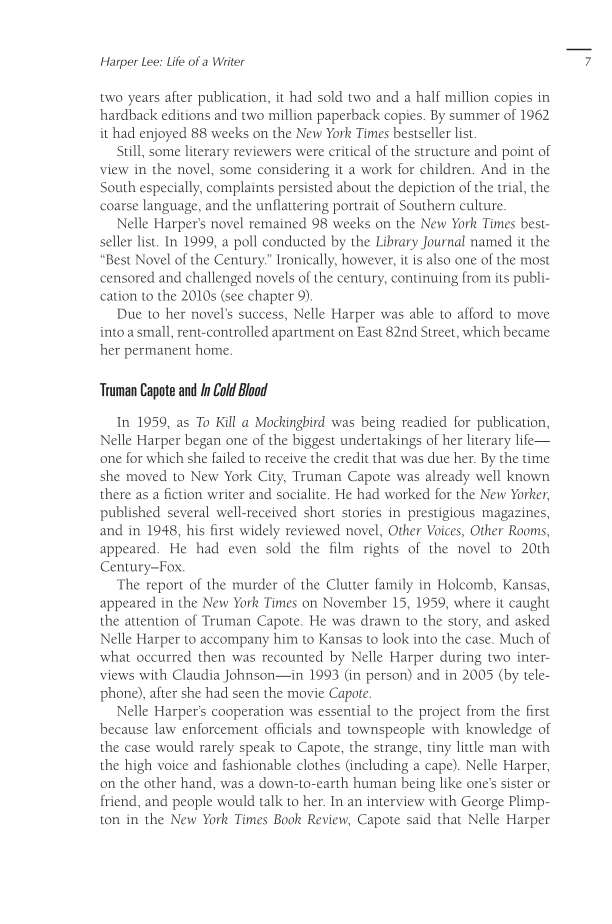Harper Lee: Life of a Writer 7 two years after publication, it had sold two and a half million copies in hardback editions and two million paperback copies. By summer of 1962 it had enjoyed 88 weeks on the New York Times bestseller list. Still, some literary reviewers were critical of the structure and point of view in the novel, some considering it a work for children. And in the South especially, complaints persisted about the depiction of the trial, the coarse language, and the unflattering portrait of Southern culture. Nelle Harper’s novel remained 98 weeks on the New York Times best- seller list. In 1999, a poll conducted by the Library Journal named it the “Best Novel of the Century.” Ironically, however, it is also one of the most censored and challenged novels of the century, continuing from its publi- cation to the 2010s (see chapter 9). Due to her novel’s success, Nelle Harper was able to afford to move into a small, rent-controlled apartment on East 82nd Street, which became her permanent home. Truman Capote and In Cold Blood In 1959, as To Kill a Mockingbird was being readied for publication, Nelle Harper began one of the biggest undertakings of her literary life— one for which she failed to receive the credit that was due her. By the time she moved to New York City, Truman Capote was already well known there as a fiction writer and socialite. He had worked for the New Yorker, published several well-received short stories in prestigious magazines, and in 1948, his first widely reviewed novel, Other Voices, Other Rooms, appeared. He had even sold the film rights of the novel to 20th Century–Fox. The report of the murder of the Clutter family in Holcomb, Kansas, appeared in the New York Times on November 15, 1959, where it caught the attention of Truman Capote. He was drawn to the story, and asked Nelle Harper to accompany him to Kansas to look into the case. Much of what occurred then was recounted by Nelle Harper during two inter- views with Claudia Johnson—in 1993 (in person) and in 2005 (by tele- phone), after she had seen the movie Capote. Nelle Harper’s cooperation was essential to the project from the first because law enforcement officials and townspeople with knowledge of the case would rarely speak to Capote, the strange, tiny little man with the high voice and fashionable clothes (including a cape). Nelle Harper, on the other hand, was a down-to-earth human being like one’s sister or friend, and people would talk to her. In an interview with George Plimp- ton in the New York Times Book Review, Capote said that Nelle Harper
Document Details My Account Print multiple pages
Print
You have printed 0 times in the last 24 hours.
Your print count will reset on at .
You may print 0 more time(s) before then.
You may print a maximum of 0 pages at a time.

































































































































































































